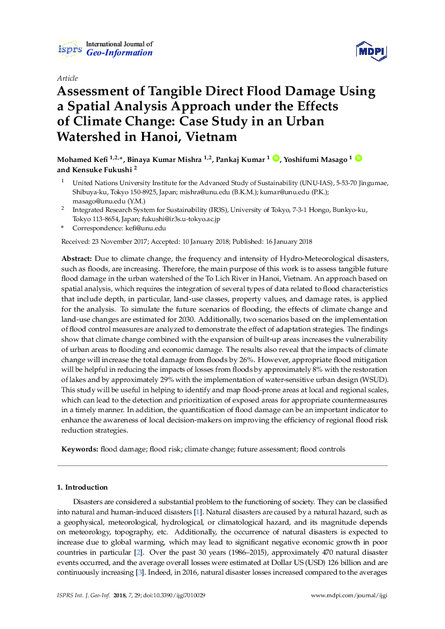
Due to climate change, the frequency and intensity of Hydro-Meteorological disasters, such as floods, are increasing. Therefore, the main purpose of this work is to assess tangible future flood damage in the urban watershed of the To Lich River in Hanoi, Vietnam. An approach based on spatial analysis, which requires the integration of several types of data related to flood characteristics that include depth, in particular, land-use classes, property values, and damage rates, is applied for the analysis. To simulate the future scenarios of flooding, the effects of climate change and land-use changes are estimated for 2030. Additionally, two scenarios based on the implementation of flood control measures are analyzed to demonstrate the effect of adaptation strategies.
The findings show that climate change combined with the expansion of built-up areas increases the vulnerability of urban areas to flooding and economic damage. The results also reveal that the impacts of climate change will increase the total damage from floods by 26%. However, appropriate flood mitigation will be helpful in reducing the impacts of losses from floods by approximately 8% with the restoration of lakes and by approximately 29% with the implementation of water-sensitive urban design (WSUD). This study will be useful in helping to identify and map flood-prone areas at local and regional scales, which can lead to the detection and prioritization of exposed areas for appropriate countermeasures in a timely manner. In addition, the quantification of flood damage can be an important indicator to enhance the awareness of local decision-makers on improving the efficiency of regional flood risk reduction strategies.
Links
Resource collections
- Floods
- Learning from crises
- UN Habitat - Urban Response Collection
- Urban Response - Urban Crisis Preparedness and Risk Reduction
- Urban Response Collection - Community Engagement and Social Cohesion
- Urban Response Collection - Economic Recovery
- Urban Response Collection - Environment and Climate Change
- Urban Response Collection - Housing, Land and Property
- Urban Response Collection - Urban Crisis Response, Recovery and Reconstruction
- Urban Response Collection - Urban Resilience